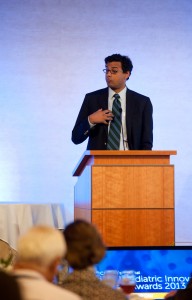 Wrapping up the National Pediatric Innovation Summit + Awards on Sept. 27, emcee Bruce Zetter, PhD, who runs a lab in Boston Children’s Vascular Biology program, remarked, “I thought I was going to learn about technology. What I learned about was communication.”
Wrapping up the National Pediatric Innovation Summit + Awards on Sept. 27, emcee Bruce Zetter, PhD, who runs a lab in Boston Children’s Vascular Biology program, remarked, “I thought I was going to learn about technology. What I learned about was communication.”
Surgeon, writer and public health researcher Atul Gawande, MD, MPH, laid bare this often overlooked element of medicine in his closing keynote. He eloquently made the point that communication—and more specifically systems—is where innovation is most needed and where it can have the most impact.
“We have emerged from the century of the molecule to the century of the system,” Gawande said.
Right now, these systems are broken, seemingly everywhere. Gawande recounted the sad tale of Duane Smith, a patient who survived a severe car crash that ruptured his spleen, only to lose his fingers, toes, nose and job from an ordinary strep infection. The crash had ruptured his spleen, and he should have received a vaccine to guard against strep, “one of the innovations of the past century.” But the vaccine was never given to him. Smith became septic while on vacation and nearly died.
“What was striking was that he was cared for by good, hardworking people, but there was no system around what they were trying to do,” Gawande said. “It turns out that about half of people whose spleens are removed get this important step missed.”
The system is like a machine in which diverse components ought to fit and work together, but too often they don’t, in part because of the system’s complexity. “A mechanic would say, having great components is not enough,” Gawande said. “But we in medicine have been obsessed with having the best components.”
Imagine building a car this way, from the very best parts: the brakes of a Porsche, a Ferrari engine, the suspension of a BMW, the chassis of a Volvo. “You’ll get a very expensive pile of junk that doesn’t work properly. Sometimes that’s exactly what medicine can feel like.”
Gawande felt it when his mother was in the hospital. He counted 63 people involved in her care, including nine physical therapists. One would come in and scold her for still being in bed. Later, another would order her back into bed. “That is not care.”
Outcomes vary greatly depending on where you go for care, Gawande has found. With treatment advances, patients with cystic fibrosis currently live to an average age of 35 (as compared with around 6 years old in the 1960s). “But there’s a bell curve,” said Gawande. “In some places, the average survival is more than 48 years, and there are some where it’s not broken the late twenties.”
There’s a similar bell curve for costs at different centers, and it doesn’t match the survival curve. “The most expensive places in the country are not the places that are getting the best results,” he said.
We can learn by observing the centers where the systems are working, according to Gawande. One of these is a program at Boston Children’s Hospital known as the Community Asthma Initiative. Clinicians used a systematic checklist, one of whose items is to make sure the parent had a prescription for a controller inhaler. They found a large proportion of the parents didn’t know how to give the controller properly. Visiting the homes, they found mold, rodents and dust, and often, no vacuum cleaner.
“They wrote prescriptions for vacuums, which are cheaper than the controllers,” Gawande said. After one year, asthma hospitalizations had fallen by 80 percent.
Even in basic science there’s a new appreciation for systems. “We’ve done reductionism—taking it down to the gene, neuron, microchip—and it has saved enormous lives,” he said. “But fundamentally important is how all those molecules work together, how genes work together, how neurons end up fitting together and producing the emergent properties of the brain.”
Gawande described three commitments needed to change the system. The first is a commitment to data, which can indicate whether what you’re doing is succeeding or failing. The second is a commitment to innovation—creatively solving the problems that emerge from the data. The third and hardest is implementing what you’ve discovered at a large scale.
That’s where prioritization is important, focusing on the most dangerous and costly moments in people’s lives. That’s the mission of Ariadne Labs, a joint center for health systems innovation that Gawande directs at Brigham and Women’s Hospital and the Harvard School of Public Health.
“What are the most critical moments of peoples’ lives when they turn to the health care system, and how do we make those critical moments work best?” he asked. “Some people with the greatest needs receive the worst care, because the complexity uncovers the frailties in the system. What we’re learning is that the value of this work dwarfs the value of all other types of health care innovations.”







